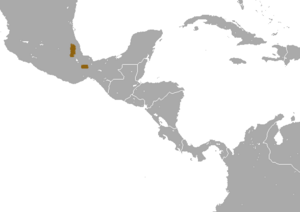Large-toothed shrew facts for kids
Quick facts for kids Large-toothed shrew |
|
|---|---|
| Conservation status | |
| Scientific classification | |
 |
|
| Large-toothed shrew range |
The large-toothed shrew or Mexican large-toothed shrew (Sorex macrodon) is a tiny mammal. It is one of 77 different types of shrews in the Sorex family. This shrew is considered vulnerable, meaning its population is shrinking. Scientists have only seen the Mexican large-toothed shrew 14 times in seven places. It belongs to a group of shrews known for having long tails compared to their body size.
Contents
Where the Large-Toothed Shrew Lives
The large-toothed shrew lives only in Mexico. Its home covers an area of about 6,400 to 12,000 square kilometers. These shrews like to live in damp, mossy areas and thick oak forests. You might find them under rocks or logs, near streams, or in grassy spots.
They prefer forests with pine and oak trees, or tropical forests. These special places are found inside the Trans-Mexican Volcanic Belt in southern Mexico. This area is very important because it has many different kinds of plants and animals. More than 75% of the large-toothed shrew's scattered population lives here.
These shrews spend all their time on the ground. They share their homes with other animals like certain mice and rabbits. They also live in high mountain areas, up to 4200 meters high. Other shrews like S. veraepacis, S. saussurei, and S. trowbridgii also live in these mountains. The large-toothed shrew is found in specific parts of southern Mexico, including Veracruz, Oaxaca, and Puebla.
Why the Large-Toothed Shrew is in Danger
The biggest threat to the large-toothed shrew is the destruction of its forest home. People are cutting down forests, which makes the shrew's habitat smaller. By 2005, about 84% of the shrew's original home was no longer suitable for them. Sadly, less than 16% of their habitat was still healthy after forests were cut down.
When shrews live near farms, they can be harmed by pesticides. These chemicals can affect them directly or through the food they eat. Losing the edges of their habitat, like forest lines or grassy borders, also makes it harder for them to survive.
Because their population is small and spread out, even small problems can be very dangerous. Things like mining, raising farm animals, cutting wood, or forest fires could wipe out the entire population. Unfortunately, not much is known about the Mexican large-toothed shrew, even in its own country. Farming and city growth are the main reasons why Sorex macrodon is at risk of extinction.
What the Large-Toothed Shrew Eats
The large-toothed shrew mainly eats insects. It also feeds on small spiders and sometimes a bit of plant material.
How the Large-Toothed Shrew Looks
The Mexican large-toothed shrew is quite large for a shrew. It can be about 11.8 centimeters long or more, with a hind foot around 1.5 centimeters. Its fur is a mix of reddish-brown and black, which is lighter than some other shrews. Its belly is a light tan color.
The shrew's skull is big and strong. It has large, sturdy teeth and strong edges around its front nostrils.


